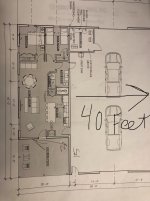Macinnis
Gold Member
I have a 60x60 pole barn. All posts are 10,000 psi concrete posts set in ground with concrete and dirt material filling the 4 foot hole they are set in. At 6 inches out of ground they are 3 2x6s screwed together up to the truss.
20x45 of this space will be used as an apartment with the remaining 15 foot as a covered patio. The remaining 40x60 will be used as a barn/shop.
I had the concrete guy out today to do a final inspection of the grade (now that I finished my plumbing) and control joints came up.
Concrete guy said: the living quarters does not need to do any control joints, we will just do one on your long wall (separating the shop from the apartment).
They will be doing cut in control joints in the 40x60 shop side. He was trying to be nice I believe and not show any control joints in the living quarters side.
My question is...should I have him put in some control joints in the living quarters side, regardless of what they look like?
The barn sits on level ground with 4-6 inches of compacted gravel with fines and then 4-6 inches of clean gravel on top of that.
Edit: the slab will be 4-5 inches thick, over 4000 psi, with rebar on chairs and fibers.
All opinions appreciated.
Thanks,
Bill
20x45 of this space will be used as an apartment with the remaining 15 foot as a covered patio. The remaining 40x60 will be used as a barn/shop.
I had the concrete guy out today to do a final inspection of the grade (now that I finished my plumbing) and control joints came up.
Concrete guy said: the living quarters does not need to do any control joints, we will just do one on your long wall (separating the shop from the apartment).
They will be doing cut in control joints in the 40x60 shop side. He was trying to be nice I believe and not show any control joints in the living quarters side.
My question is...should I have him put in some control joints in the living quarters side, regardless of what they look like?
The barn sits on level ground with 4-6 inches of compacted gravel with fines and then 4-6 inches of clean gravel on top of that.
Edit: the slab will be 4-5 inches thick, over 4000 psi, with rebar on chairs and fibers.
All opinions appreciated.
Thanks,
Bill

